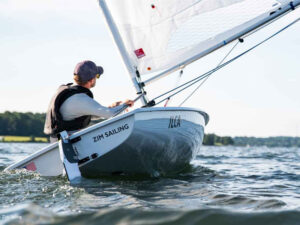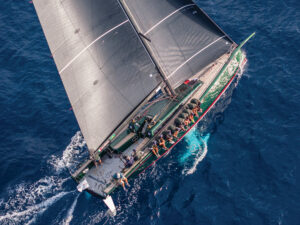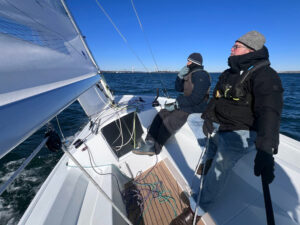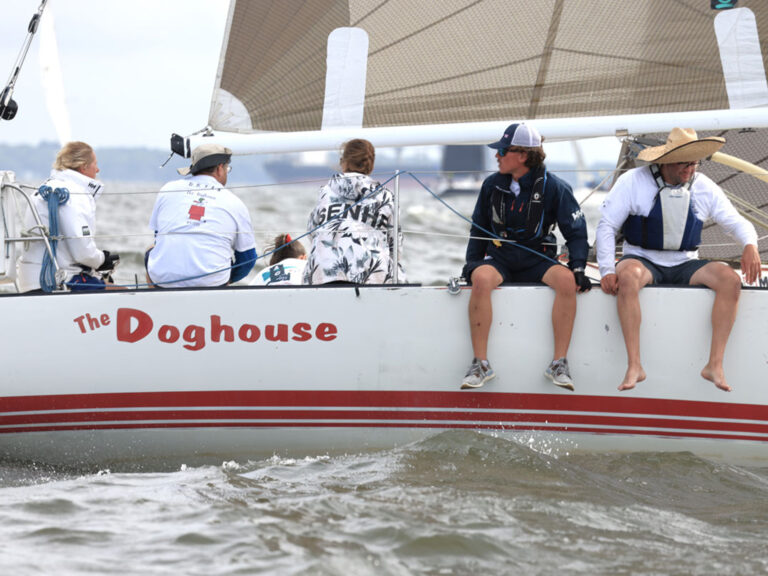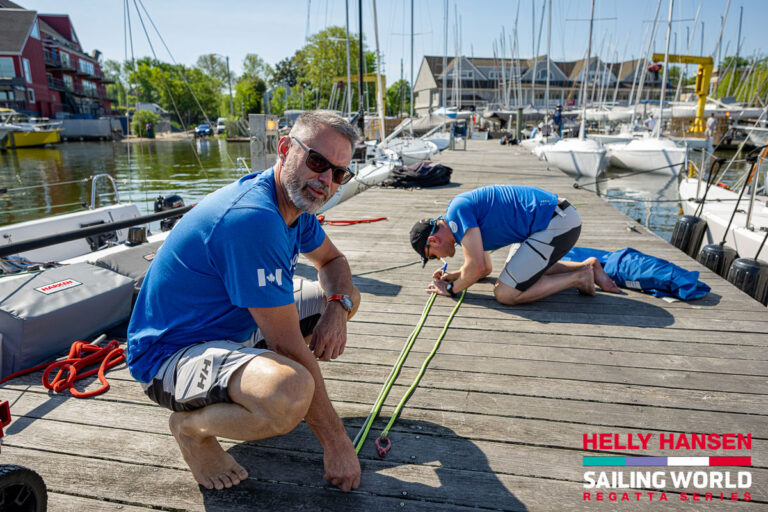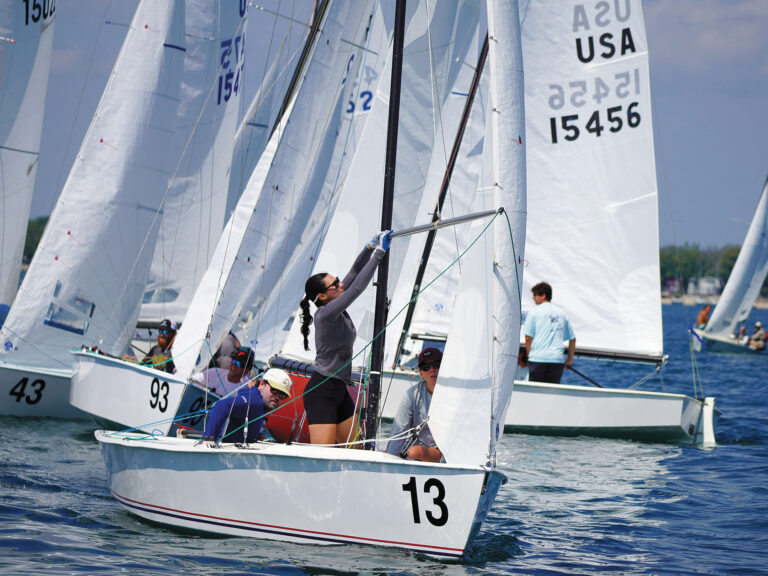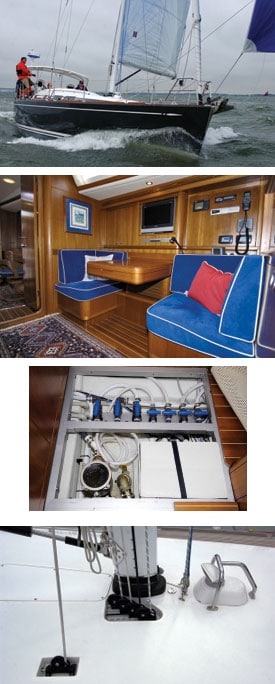
Swan46Pics
There are few name brands in the world of sailing as well-known as Nautor’s Swan. The racey good looks, teak decks, and high level of craftsmanship have imprinted themselves on the psyche of a generation of sailors. Under the influence of Leonardo Ferragamo, who purchased the Finnish company with a group of investors in 1998, Nautor has been updating its product line with both raceboats and performance cruisers. We had the opportunity to sail the latest design, the Swan 46, last fall in Annapolis, and while it’s marketing target is cruising sailors, we found it to be a responsive, great-sailing boat with the chops to get the job done on the racecourse, too. The standard mast on the 46 is made of IRC-friendly aluminum, with two sets of swept spreaders. A carbon rig is a $75,000 option. The cockpit has two wheels, which allows for easy passage from the companionway to the drop-down transom door-which doubles as a gangway when moored stern to a dock. The helmsman’s seat lifts out of the way easily, courtesy of a gas piston. Another concession to comfort is the absence of a traveler, but Swan has reinforced the boom and the vang, so vang-sheeting helps compensate for the loss of the traveler. To keep shorthanded skippers in the cockpit, the main is reefed with a single-line system, which leads to the cockpit The deckhouse is long and low, and sports the trademark dark-blue stripe, in which the four portlights seem to disappear. A lot was done to free the deck area of obstructions; the turning blocks for the halyards at the base of the mast are sunk into the deck, as are the halyards, which don’t re-appear until they exit the coaming surrounding the companionway. The mainsheet, which is rigged grand-prix style, also runs under the deck to a spot just forward of the helmsman. The roller-furler drum for the headsail is rigged below the deck as well. The only protrusion on the deckhouse is the dorade vent forward of the mast, and it’s well protected by a cage of metal tubing. The Swan 46 motors at 8 knots with the 53-horsepower Volvo saildrive at 2,800 rpm., powering a three-blade folding prop. An option for those who wish to make it home to the marina faster is a 75-horsepower engine driving a four-blade folding prop. Our backdown test showed a slight tendency to pull to the left, but the twin rudders manage that tendency nicely. Two turns is all it takes for the helms to go lock-to-lock, which means handling is crisp and tight. The 46 we sailed is equipped with a fiberglass daggerboard and twin rudders, an optional package for shallow waters which gives the boat a draft of 4’4″ with the board up, 11’1″ board down. Being racing sailors, one of the first tests we did while sailing downwind was to raise the board to see how much faster the 46 would go without it; we went from 9.5 to 10 knots with an asymmetric spinnaker up in 16 to 18 knots of wind. We also figured out when the daggerboard is up, having both rudders in the water was better than having only one; when we pressed the 46 and the weather rudder came clear of the water, we could feel the leeward rudder start to cavitate. The daggerboard is ballasted, driven by hydraulics, and can go from up to full depth in 4 seconds, and up again in 12. If the electric motor that drives the hydraulics isn’t working, the daggerboard can be manually pumped up or down, or lifted by a halyard through a hatch located directly over the daggerboard housing in the salon. The daggerboard is “somewhat sacrificial,” according to Nautor, and will break before it damages the structure of the boat. There’s a panic switch, which, if you feel the keel strike something, pulls the board up, very quickly. The full batten mainsail attaches to the mast with an Antal batten-car system, which, when combined with the power winch on the cabin top, makes for a sail that’s a cinch to set. We sailed upwind with a full main and 543 square foot headsail, and enjoyed every minute. The 46 is almost, but not quite a masthead rig (31/32), so the non-overlapping jib is tall, and has plenty of grunt. It’s the small details in the interior that add up and make a Swan a Swan: the floorboards are all labeled, so if the floorboards have to come out, putting them back in is easy. If a floorboard is damaged or lost, the factory can replace it from the same lot of teak; they keep each boat’s details on file. When one of the floorboards is lifted with the Swan suction-cup handles, deep bilges and an aluminum framework are visible. When there’s plumbing, every tube, pipe, through-hull fitting, and hose is labeled. All fuel tanks are designed to be removed through the companionway if necessary. The two chairs found below can be moved anywhere in the cabin, but when the weather gets rough, they lock down into fittings built into the floorboards. At first glance, there appears to be no nav station. In its place are two bench seats and a small table just forward of the galley to starboard, and across from the settee and its table. But when it’s time to navigate, a flat screen monitor that doubles as an entertainment system is pulled out from the bulkhead on an articulating arm and the area turns into a nav station. Frers and Swan understand how navigation has become mostly digital, and has turned a semi-wasted space into a dual-purpose masterpiece. It’s obvious this latest Swan isn’t a flat-out racer, in fact, it’s downright luxurious. But for those who walk both sides of the cruiser/racer divide, it’s a boat that will satisfy both needs with aplomb. Whether it be a doublehanded race to Bermuda, or simply a friendly race to the best mooring after a day of cruising, the Swan 46 will get you there with style and speed. Swan 46 Specs LOA 46′ Beam 14′ DSPL 36,800 lbs. SA (u/d) 1,201 sq. ft./ 2,854 sq. ft. Design German Frers Price $770,000 www.nautorsswan.com

